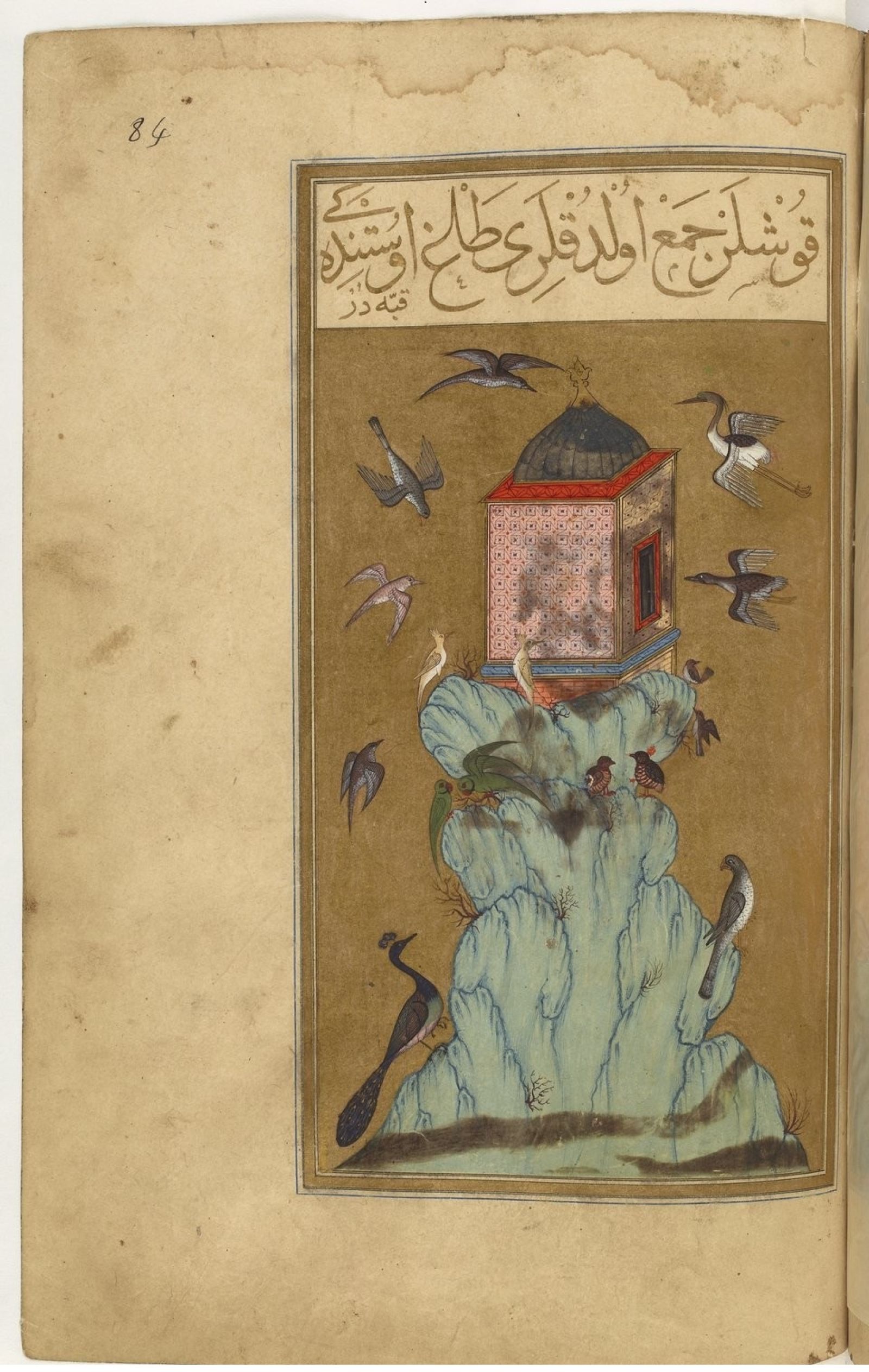Workshop
Mapping Animals in Global Spaces
Interdisciplinary Workshop organised by Christine Kleiter, Lianming Wang and Gerhard Wolf

Ottoman miniature painting showing a bird house, in Seyyid Muhammed bin Emir Hasan el-Saudî, Metaliʿü'l-saadet ve yenabiʿü-l-siyadet, 1582. Paris, BnF, Département des Manuscrits. Supplément turc 242, fol. 84r.
Human-animal interferences occur in specific spatial settings. Animals are and have been affected spatially by various human actions and endeavors including migration, agricultural exploitation, war, trade, geographical exploration, scientific expeditions, imperialism, and colonialism. But, the ‘silent (or not so silent) neighbors’ do not merely surround humans; they too are migrants as well as active producers of space and built environments. Much as human beings migrate, create, and shape the space around them, animals create dwellings as natural spectacles, form and transform natural (and urban) landscapes, and interact with humans in space through resistance, co-habitation, and (re-)occupation. Artificial environments may relocate nonhumans from ‘wilderness’ to ‘civilized’ enclosures, whereas humans benefit from spaces created by animals.
Moving beyond narratives of subordination and oppression, this interdisciplinary workshop aims to foster a critical debate by exploring spaces that create significant interspaces of tension and confrontation, but also conciliation and coexistence (sometimes even mutual dependence), between humans and nonhumans. Particular attention will be given to artistic practices and architecture and their relations to ecological, anthropological, historiographical, and methodological debates. The workshop is eager to understand how animal spaces have been observed, documented, perceived, and imitated on a global horizon. Furthermore, it questions what impact these practices (and therefore the agency of animals) had or have on human space and what future perspectives regarding built and shaped environments are.
PROGRAM
Thursday, January 25th
10.30 Welcome (Gerhard Wolf)
10.40-11.10 Introduction (Christine Kleiter and Lianming Wang)
Panel I: Animals in Architecture
Chair: Hana Gründler
11.10-11.40 Anna Blume (New York), The Creative Practice of Spiders
11.40-12.10 Mary Danisi (Cornell/Rome), Obscure Architecture: Boukrania, Fillets, and Light Effects of the Mysteries
12.10-12.40 Sanja Savkić Šebek (London), The Significance of Animals in the Artistic and Architectural Traditions of the Ancient Maya
12.40-13.00 Discussion
Lunch Break
Panel II: Spaces of Symbiosis
Chair: Hannah Baader
14.00-14.30 Elizabeth Tavella (Chicago/Rome), The Biopolitical (Un)making of the Wild: Liminal Ecologies in the Zoo
14.30-15.00 Tairan An (Princeton), Incidental Artifacts: Aquatic Epistemologies and the Architecture of Water-Biology at the Bay of Naples, c. 1870s (online)
15.00-15.30 Gianlorenzo Chiaraluce (Rome), Relational Hives: Artistic Practices of Interconnection between Bees and Humans
15.30-15.45 Discussion
15.45-16.00 – Coffee Break
Panel III: Animals in Pictorial Space
Chair: Lianming Wang
16.00-16.30 Chloé Pluchon-Riera (Grenoble), Margins: Specific Spatial Settings for Animals in Early Modern Italian Paintings (online)
16.30-17.00 Dingding Wang (San Diego), Coving Whales: The Poetics and Visuality of Japanese Traditional Whaling
17.00-17.30 Mei Mei Rado (New York), Woven Animals: the Tenture des Indes for the Qing emperor
17.30-17.45 Discussion
18.00-18.45 Troy Vettese (Florence), Half-Earth Socialism in One Country
Friday, January 26th
Panel IV: Spaces of Livestock
Chair: Christine Kleiter
14.00-14.30 Zhengfeng Wang (Leiden), A City of Three Abattoirs
14.30-15.00 Sofia Nannini (Turin), Architects and the Design of Animal Farming: Cedric Price’s Research Documents for Westpen (1977-79)
15.00-15.30 Filiz Tütüncü Çağlar (Berlin), Of Horses and Men: Archaeology of Stables in Medieval Cappadocia
15.30-15.45 Discussion
15.45-16.00 – Coffee Break
Panel V: Animals and Urbanism
Chair: Gerhard Wolf
16.00-16.30 Noemi Quagliati (Venice), Flying Visions, Atmospheres, Chicken Eggs: The Bird Space in the History of Photography
16.30-17.00 Nathalie Kerschen (Rome), Urbs animalis: a Situated Case Study of Rome’s Animals as Co-habitants, Dwellers & Agents
17.00-17.30 Anna Caramuru Aubert & Laura Pappalardo (Münster/Sao Paolo), Reimagining Interspecies Relations: Challenging Human Exceptionalism through Artistic, Architectural, and Place-Making Animal Agency (online)
17.30-17.45 Discussion
17.45-18.00 Conclusion (Gerhard Wolf)
Downloads
25. – 26. Januar 2024
This will be a hybrid event.
Venue
Palazzo Grifoni Budini Gattai
Via dei Servi 51
50122 Firenze, Italia
Hinweis
Diese Veranstaltung wird durch Fotografien und/oder Videoaufnahmen dokumentiert. Falls es nicht Ihre Zustimmung findet, dass das Kunsthistorische Institut in Florenz Aufnahmen, auf denen Sie erkennbar abgebildet sein könnten, für die Veranstaltungsdokumentation und Öffentlichkeitsarbeit (z.B. Social Media) verwendet, bitten wir um eine entsprechende Rückmeldung.


